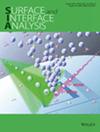Surface science insight note: Optimizing XPS instrument performance for quantification of spectra
IF 1.8
4区 化学
Q4 CHEMISTRY, PHYSICAL
引用次数: 0
Abstract
X‐ray photoelectron spectroscopy (XPS) provides quantitative information from photoemission peaks and shapes observed within the background due to the inelastic scattering of photoelectrons. To quantify the signal, both photoemission peaks and background in spectra must be adjusted for instrumental transmission variations that are a consequence of changes in efficiency when recording electrons with different kinetic energy. While it is generally assumed that correcting spectroscopic data for transmission is a necessary part of quantification by XPS, there are consequences for the quantification of spectra measured using an instrument for which transmission has significant curvature. In this表面科学启示录:优化 XPS 仪器性能,实现光谱量化
X 射线光电子能谱(XPS)可从光电子非弹性散射造成的背景中观察到的光发射峰和形状提供定量信息。为了量化信号,必须对光谱中的光发射峰和背景进行调整,以适应仪器透射率的变化,这是记录不同动能电子时效率变化的结果。虽然人们普遍认为根据透射率校正光谱数据是 XPS 定量的必要部分,但使用透射率具有明显曲率的仪器测量光谱时,会产生一些量化后果。在本《洞察》中,讨论了透射特性中曲率的影响,并提出了一种基于 XPS 显微镜的方法,以确保仪器的透射响应没有明显的曲率。通过使用设计用于测量残像的透镜模式收集光谱,介绍了一个实现平坦透射响应的仪器示例。
本文章由计算机程序翻译,如有差异,请以英文原文为准。
求助全文
约1分钟内获得全文
求助全文
来源期刊

Surface and Interface Analysis
化学-物理化学
CiteScore
3.30
自引率
5.90%
发文量
130
审稿时长
4.4 months
期刊介绍:
Surface and Interface Analysis is devoted to the publication of papers dealing with the development and application of techniques for the characterization of surfaces, interfaces and thin films. Papers dealing with standardization and quantification are particularly welcome, and also those which deal with the application of these techniques to industrial problems. Papers dealing with the purely theoretical aspects of the technique will also be considered. Review articles will be published; prior consultation with one of the Editors is advised in these cases. Papers must clearly be of scientific value in the field and will be submitted to two independent referees. Contributions must be in English and must not have been published elsewhere, and authors must agree not to communicate the same material for publication to any other journal. Authors are invited to submit their papers for publication to John Watts (UK only), Jose Sanz (Rest of Europe), John T. Grant (all non-European countries, except Japan) or R. Shimizu (Japan only).
 求助内容:
求助内容: 应助结果提醒方式:
应助结果提醒方式:


